Are you looking for how to create a natural habitat for Betta fish in your aquarium? You are in the right place!
Keep reading to learn how to create a natural habitat in your aquarium.
To create a natural Betta habitat for your Betta in your aquarium, you need an appropriately sized aquarium, live plants endemic to the Betta fish’s natural habitat, essential aquarium equipment, and a sufficient load of nitrifying bacteria.
You’ll also need some creativity and vital information to build a Thai river for your Betta.
Keep reading to learn the vital specifics for creating the most natural habitat for your Betta fish.
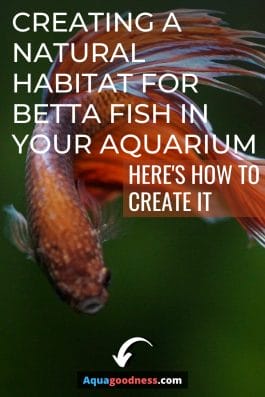
Table of Contents
What Are the Must-Haves of a Natural Habitat Betta Aquarium?
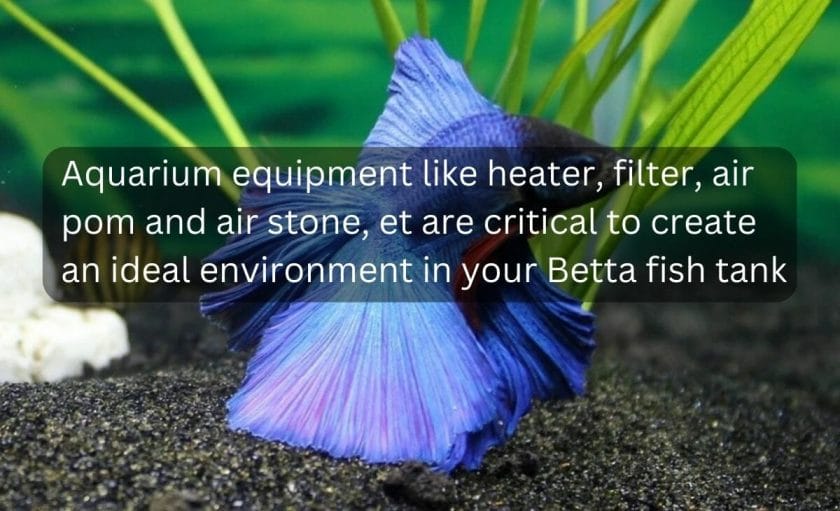
Whether you are new to the fish-keeping hobby or not, some accessories must be on hand to create a natural habitat for Betta fish in your aquarium.
These accessories include the following:
Fish tank
Choosing the right fish tank size is one of the most important things when you want to not only create a natural habitat for your Betta fish but for the Betta fish to survive and live a happy life.
Betta fish can live in as small as a 2.5-gallon tank. However, it is not recommended to keep a Betta fish in that small of a tank, especially if you’re a beginner.
And as you are trying to create a natural habitat for your Betta fish, you just can’t do a lot to emulate the natural habitat in a 2.5-gallon tank.
Besides, there are a lot of benefits to having a bigger tank:
- In a bigger tank water parameters don’t fluctuate as quickly as they can in a smaller tank. If the water parameters change quickly in your tank, it will stress your Betta fish.
- Nitrates, a harmful bi-product to your Betta fish, build up slowly in a bigger tank compared to a smaller tank.
So what’s the ideal tank sizer for a Betta fish tank?
The ideal tank size for Betta fish is at least a 5-gallon tank. If you can go more than that, maybe a 7.5-gallon or a 10-gallon tank, that’ll be even better.
I keep my Betta fish in a 7.5 US gallon (28 liters) tank.
Suitable Filters
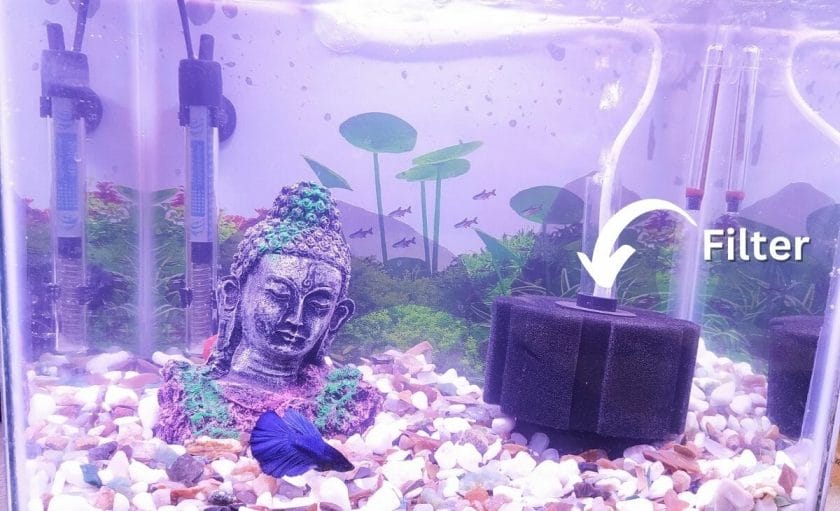
Getting filters is one part; ensuring that your filters are not overkilling is the second.
Although constant filtration delays the growth and build-up of harmful microbes and organic waste from fish waste and uneaten fish food, over-filtering will make it challenging for your aquarium to build a proper layer of beneficial bacteria.
The beneficial bacteria will find it difficult to settle if your aquarium water is moving too fast. Hence, your aquarium will take longer to mature and cycle.
You want a slow-moving filter with at least a 5-10 GPH turnover rate for smaller aquariums. The Fluval Nano Aquarium Filter is a great pick if you run an aquarium in the small size range.
The cool part about this filter is that it works great with 5-15 gallon aquariums. I prefer the Fluval Nano Aquarium Filter because it is compatible with the Fluval Nano Carbon Cartridge.
The carbon cartridge is necessary because it absorbs discolorations, odors, and impurities in your aquarium water.
For aquariums in the medium size range (20-40 gallons), the Fluval U2 Underwater Filter A470. is the filter for the job.
For smaller aquariums of up to 10 gallons, you could also use a sponge filter as the only filter. And for bigger aquariums, you could use a sponge filter as a secondary and/or backup filter in case your primary filter stops working.
The benefit of using a sponge filter is that it produces very low water current flow, which Betta fish prefer.
Besides, it is very easy to set up. And it helps to keep your fish tank well-oxygenated.
The drawbacks of a sponge filter are:
- It doesn’t has chemical filtration which you get in a HOB filter
- And it takes up a good amount of space in your aquarium
- A lot of people don’t like the look of it in their aquarium
However, I do like a sponge filter in my Betta fish tank (As you can see in the picture down below. Yeah, it’s my beautiful Betta tank). And many experienced aquarists think it’s essential for any aquarium.
Water Heater
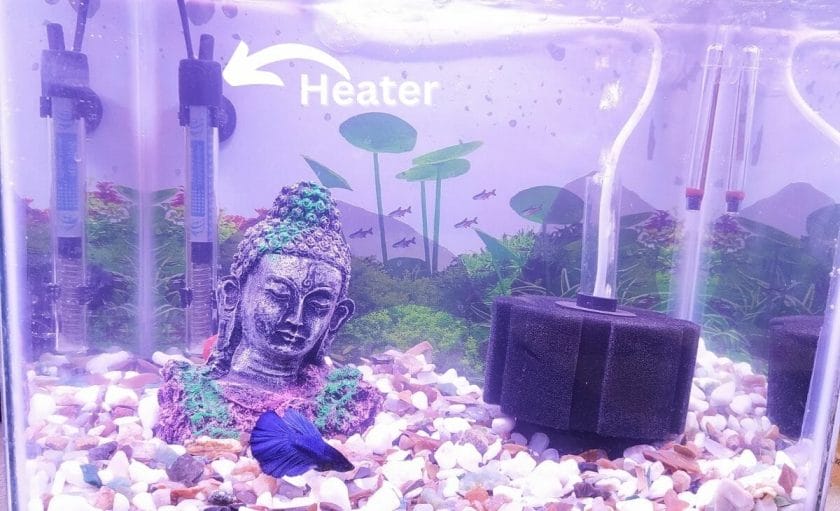
Bettas are a tropical fish species, so they must be kept within a temperature range of 75°F – 83°F.
Cold water will stress your Betta and ultimately kill them. But too warm or hot water speeds up metabolism and aging for Bettas. So you must choose the appropriate heater.
If you live in an area where the climate is cold and the temperature drops rapidly, you need an aquarium heater.
During the winter and other times of the year when there is a significant drop in temperature, you’ll need a heater to maintain the warm water temperature that a Betta fish need.
Choosing the right heater is very important for two reasons:
- If the heater is too much for your aquarium, you may end up cooking your fish slowly in the aquarium.
- Since dissolved oxygen levels drop rapidly in heated water, if the heater is producing too much heat, your Bettas will have less oxygen supply.
Aquarium heaters come in different wattages, and the right wattage will depend on the size of your aquarium.
The Fluval P25 Submersible Aquarium Heater 25w is a great choice if you are using a 5 – 10 gallon tank. I like this heater because, since it is submersible, its shatterproof design protects the Betta in your aquarium.
You can check the latest price of this heater at Amazon here
However, you’ll need something like the 200w Hygger 25-50 Gallon Small Aquarium Heater for a 25-50 gallon aquarium. This heater is cool for so many reasons, some of which are;
- It comes in different wattages for different ranges of aquarium sizes; there is a 100w variant for 10-25 gallon aquariums, 200w for 25 – 50 gallons, and more.
- The heater has an intelligent controller which turns it off when the temperature reaches a preset maximum and turns it back on when the temperature drops below a preset minimum.
- In the event of a power failure, the heater remembers the temperature you set when the power comes back on.
You can check the latest price of this heater at Amazon here
Air Stones and Air Pump
Air stones in your aquarium will provide an oxygen-rich ecosystem for your Bettas.
Your aquarium’s water temperature will be on the high side because Bettas are tropical fish. So you’ll need to add an air pump and some air stones or bubblers to maintain a good oxygen level in the water.
Bubblers do three main things for your aquarium;
- They make the bubbles from the air pump smaller. This is important because the bigger bubbles will agitate and stress your Bettas.
- They reduce the noise from the bubbling by making the bubbles smaller.
- The airstones increase aeration since smaller bubbles circulate the aquarium better than bigger bubbles from the air pump directly.
The Carefree Fish Aquarium Nano Air Stone Disk is a good choice for your aquarium. I like this air stone, especially because it comes in various sizes you can choose from for your tank.
You can choose to get the size you like. Also, the airstone is designed to be resistant to acids and alkalis.
If you are a sucker for fancy decorations, the AnxunJim Aquarium Groot Air Bubbler is a great choice.
You need to choose a compatible air pump for your bubblers.
Air pumps supply a large quantity of air to your air bubblers so that you can increase the supply of oxygen for your Bettas.
AQQA Aquarium Air Pump Quiet Fish Tank Aerator Pump.
It comes in 2.5w which can power up to 100 gallons, 5w which can power up to 160 gallons, and 8 watts which can power up to about 300 gallons.
One of the coolest things about this product is how it is adjustable to meet the needs of your aquarium.
Trust me, you need a quiet air pump, especially if you’re keeping the aquarium in your bedroom.
I set up my first Betta fish aquarium in my bedroom. As I was new to the hobby I didn’t realize the importance of having a quiet air pump.
So I chose the air pump whose specifications like liked and the price seemed reasonable.
But when I set up my aquarium and turned on the air pump it was so loud!
The first day I set up the aquarium, I had to sleep in the living room instead of the bedroom where I set it up.
So, overall, the moral of the story is: get a quiet air pump!
Pro tip: If you put an aquarium sponge filter in your tank then you usually you don’t need an air pump because the bubbles coming from the sponge filter will create enough surface agitation to keep your tank well oxygeneted
The Aquascape of a Natural Habitat for Betta Fish; Here It Is

For an aquarium to qualify as a natural Betta habitat, it must have everything that a natural Betta habitat has.
These include natural decorations, live plants, a similar substrate, and sufficient colonies of beneficial nitrifying bacteria.
Read on to know your best options and how to ensure that your aquascape is as natural as possible.
Natural Decorations
Limiting the number of artificial decoration items is a great way to make the aquarium as natural as possible.
Choosing Live Plants?

Artificial plants will not make the list for any aquarium with a natural Betta habitat. The reason is simple: the habitat must be natural, with live plants instead of artificial plants.
Creating the perfect natural Betta habitat will mean that your plant choices must be plants that feature in Betta habitats in the wild.
Java ferns should be the number one plant on any list of perfect plants for a Betta tank. They are endemic to Thailand’s slow-moving freshwater streams and rivers, a natural Betta fish habitat.
What better plants to use than what they are already accustomed to in the wild?
The best part is how easy it is to plant. You only need a straight stem that has leaves and roots. Attach the roots to a rock and place it in your chosen location. It will grow and flourish fully immersed in the water.
It will do well even when the leaves protrude from the water as long as the stem and roots are fully immersed.
Cryptocoryne is another great pick that is endemic to natural Betta habitats. It is found in the rivers and streams of South Thailand. Crypts can also grow fully immersed.
You can also use Anubias, Marimo Moss balls, Sword plants, and Water sprites.
Choosing Rocks or Driftwood?
The gravel substrate is rocky already, but your Betta will like to have places to hide when it feels threatened.
These hiding places can include rocks, caves, under the covers of plants, and behind or inside any available opening in the driftwood.
These decoration choices help develop the Betta’s instincts and add a more natural look to your Betta’s habitat.
Adding rocks and driftwood to your aquarium is recommended. But you can also choose one instead of the other.
The goal is to replicate the scenery of the rivers and streams in Thailand, where they are usually found.
Substrate Choice
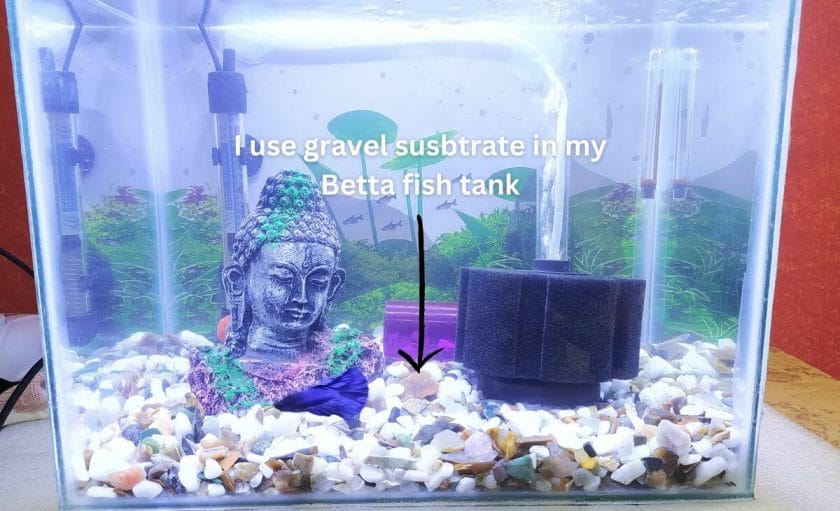
Although you can run a Betta aquarium without substrate, making it natural will require some substrate.
Sand is not recommended because it may trap so much debris you will have to rake it.
The best natural substrate for a Betta tank is gravel. It saves maintenance time, is less compact than sand, and is a great choice if you use an undergravel filter.
While choosing gravel substrate for Betta fish, make sure to choose gravel that doesn’t have sharp edges.
As for the color of the gravel substrate, you can choose any color you like. However, as we’re trying to create a natural habitat for Betta fish, ideally, you should choose gravel that looks natural like this one.
Cycling the Aquarium Water

Cycling is important to prevent “New tank syndrome” for your Betta. But more importantly, you need to cycle your tank because exposure to ammonia in the tank can be fatal in a matter of hours.
Essentially, cycling is establishing live bacteria in your aquarium. You need colonies of beneficial bacteria in your tank to filter the water as they undergo their normal life processes.
You can have the aquarium open and leave a few bits of fish food in it. The bacteria will naturally find their way into the tank as long as there is an ammonia source in it.
Alternatively, you can use bottled bacteria since they are usually pollutant-free. Besides, here are some fastest ways to cycle your Betta fish tank.
If you want to increase the chances of your Betta surviving in the aquarium, it would be best to cycle the tank first before introducing the fish.
After the tank has sustained a population of bacteria, you can introduce your Betta into its new natural habitat.
But be sure to first have the pH between 6.7 and 7.5 and the water hardness at KH: 3-5 dKH (53.6- 89.4 ppm).
Use a test kit to confirm that the nitrate level is less than 20 ppm and ammonia and nitrite levels at 0 ppm.
Cycling usually takes between 6-8 weeks. If you have only one Betta fish, you can introduce the Betta right away after the tank has been cycled.
If you plan to keep more than one, you want to add them successively after the spike in ammonia and nitrite levels drops.
FAQ
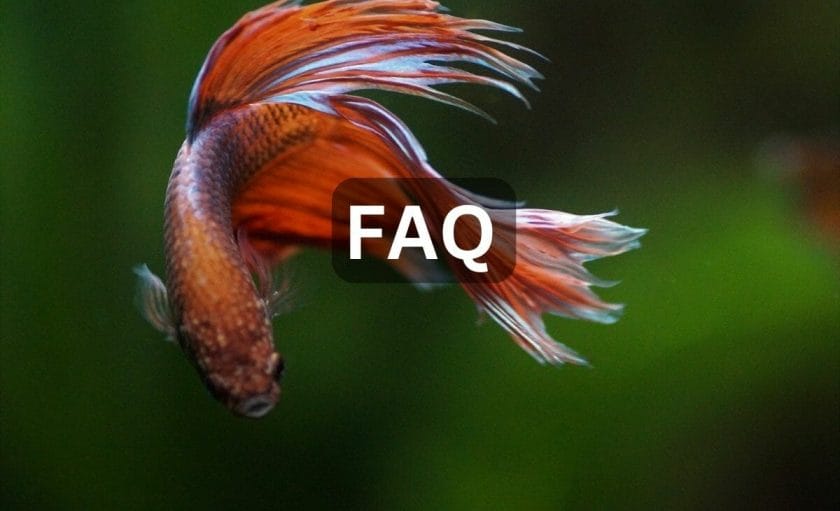
Do Bettas Need Live Plants or Artificial Plants in a Natural Habitat Aquarium?
Bettas can do well with live and artificial plants. They both provide hiding places and aesthetic value to the aquarium.
But if you want to give your Betta a natural habitat, live plants are the best choice.
Conclusion
Live plants, natural rocks, gravel substrate, and the right-sized air bubblers and air pumps create a natural habitat for your Betta.
But beyond choosing these items, you must keep in mind all the recommendations, tips, and advice above.
Don’t forget why gravel is the best substrate, why the heaters must be appropriately sized, the function of nitrifying bacteria, and the benefits of cycling the tank.